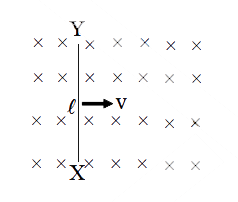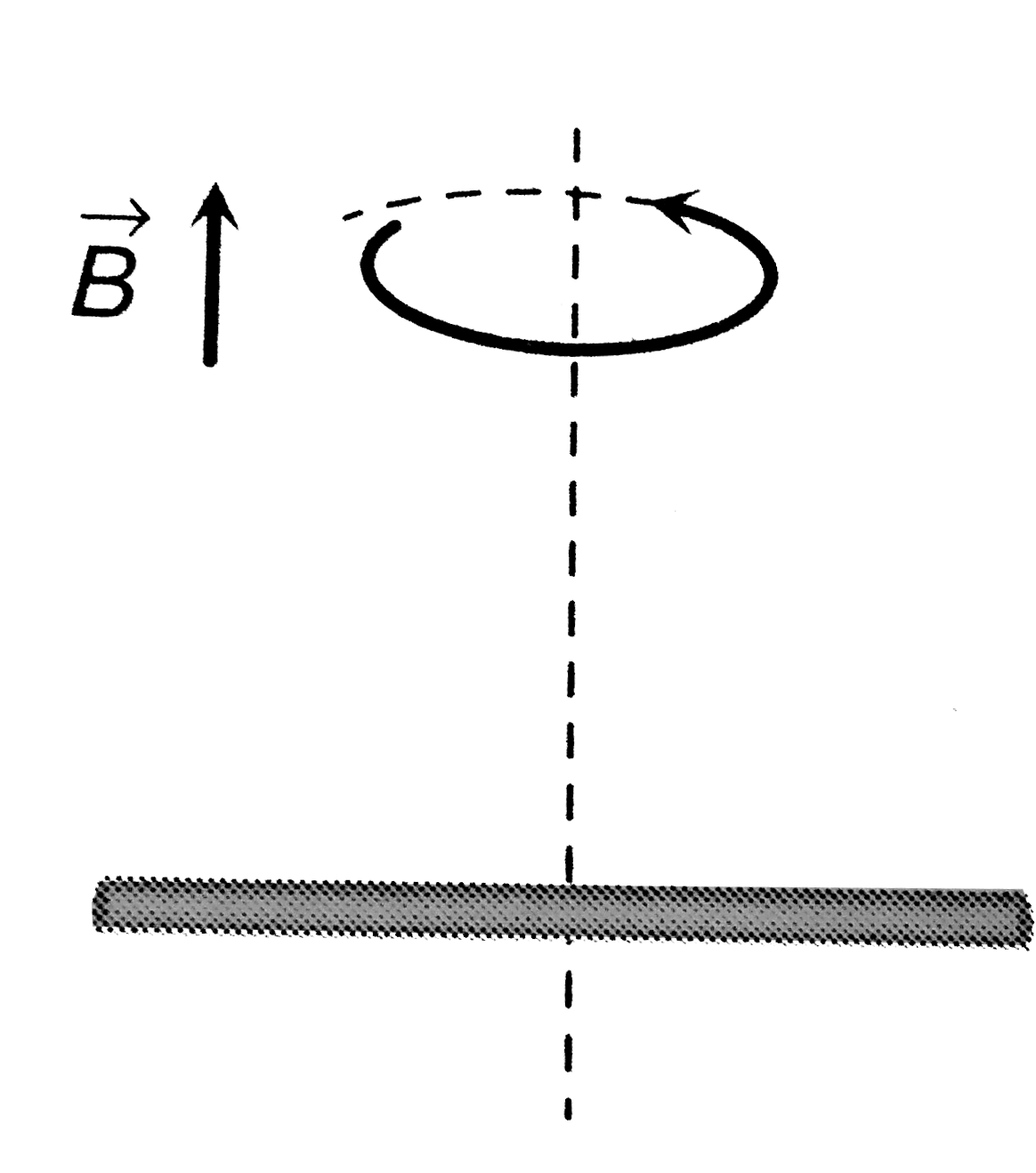A conducing rod of length l is falling with a velocity v perpendicular to a unifrorm horizontal magnetic field B . The potential difference between its two ends will be
2 B/v
B/v
12B/v
B2l2v2
The correct Answer is:B
To find the potential difference between the two ends of a conducting rod of length l falling with a velocity v perpendicular to a uniform horizontal magnetic field B, we can follow these steps:
1. Understand the Setup:
- We have a conducting rod of length l falling vertically with a velocity v.
- The rod is in a uniform magnetic field B that is horizontal.
2. Identify the Forces Acting on the Electrons:
- As the rod falls through the magnetic field, the electrons in the rod will experience a magnetic force due to their motion in the magnetic field. This force acts perpendicular to both the direction of the velocity of the rod and the direction of the magnetic field.
3. Use the Lorentz Force Law:
- The magnetic force FB on an electron is given by:
FB=q(v×B)
- Since the velocity v and the magnetic field B are perpendicular, we can simplify this to:
FB=qvB
- Here, q is the charge of the electron.
4. Establish Charge Separation:
- The magnetic force causes a separation of charges within the rod, leading to one end of the rod becoming negatively charged (excess electrons) and the other end becoming positively charged (deficiency of electrons).
5. Electric Field Induced:
- This charge separation creates an electric field E within the rod. The electric field can be expressed as:
E=FEq=FBq=vB
- Here, FE is the electric force acting on the charge due to the electric field.
6. Calculate the Potential Difference:
- The potential difference V between the two ends of the rod can be calculated using the relationship between electric field and potential difference:
V=E⋅l
- Substituting the expression for E:
V=(vB)⋅l
- Thus, the potential difference between the two ends of the rod is:
V=Blv
Final Answer:
The potential difference between the two ends of the conducting rod is given by:
V=Blv
- We have a conducting rod of length l falling vertically with a velocity v.
- The rod is in a uniform magnetic field B that is horizontal.
- As the rod falls through the magnetic field, the electrons in the rod will experience a magnetic force due to their motion in the magnetic field. This force acts perpendicular to both the direction of the velocity of the rod and the direction of the magnetic field.
- The magnetic force FB on an electron is given by:
FB=q(v×B)
- Since the velocity v and the magnetic field B are perpendicular, we can simplify this to:
FB=qvB
- Here, q is the charge of the electron.
- The magnetic force causes a separation of charges within the rod, leading to one end of the rod becoming negatively charged (excess electrons) and the other end becoming positively charged (deficiency of electrons).
- This charge separation creates an electric field E within the rod. The electric field can be expressed as:
E=FEq=FBq=vB
- Here, FE is the electric force acting on the charge due to the electric field.
- The potential difference V between the two ends of the rod can be calculated using the relationship between electric field and potential difference:
V=E⋅l
- Substituting the expression for E:
V=(vB)⋅l
- Thus, the potential difference between the two ends of the rod is:
V=Blv
The potential difference between the two ends of the conducting rod is given by:
V=Blv
Topper's Solved these Questions
- ELECTROMAGNETIC INDUCTIONBOOK - DC PANDEY ENGLISHCHAPTER - ELECTROMAGNETIC INDUCTIONEXERCISE - Taking it together
119 Videos
- ELECTROMAGNETIC INDUCTIONBOOK - DC PANDEY ENGLISHCHAPTER - ELECTROMAGNETIC INDUCTIONEXERCISE - Medical entrance special format questions
17 Videos
- ELECTROMAGNETIC INDUCTIONBOOK - DC PANDEY ENGLISHCHAPTER - ELECTROMAGNETIC INDUCTIONEXERCISE - Example
71 Videos
- CURRENT ELECTRICITYBOOK - DC PANDEY ENGLISHCHAPTER - CURRENT ELECTRICITYEXERCISE - Medical entrances gallery
97 Videos
- ELECTROMAGNETIC WAVESBOOK - DC PANDEY ENGLISHCHAPTER - ELECTROMAGNETIC WAVESEXERCISE - Sec C
22 Videos
Similar Questions
A metal rod of length 2 m is rotating with an angualr velocity of 100rads−1 in plane perpendicular to a uniform magnetic field of 0.3 T. The potential difference between the ends of the rod is
View SolutionA small conducting rod of length l, moves with a uniform velocity v in a uniform magnetic field B as shown in fig __

View Solution
Knowledge Check
A rod of length l rotates with a uniform angular velocity omega about its perpendicular bisector. A uniform magnetic field B exists parallel to the axis of rotation. The potential difference between the two ends of the lrod is
ABl2ω2BzeroC(Bl2ω8)D2Bl2ω
A copper rod of length l is rotated about one end perpendicular to the uniform magnetic field B with constant angular velocity ω . The induced e.m.f. between its two ends is
View SolutionA conducting rod of length 2l is rotating with constant angular speed w about its perpendicular bisector. A uniform magnetic field B exists parallel to the axis of rotation. The e.m.f. induced between two ends of the rod is

View SolutionA conducting rod of length 2l is rotating with constant angular speed w about its perpendicular bisector. A uniform magnetic field B exists parallel to the axis of rotation. The e.m.f. induced between two ends of the rod is

View SolutionA conducting rod of length l is rotating with constant angular velocity ω about point O in a uniform magnetic field B as shown in the figure . What is the emf induced between ends P and Q ?

View SolutionA rod of length l rotates with a uniform angular velocity omega about its perpendicular bisector. A uniform magnetic field B exists parallel to the axis of rotation. The potential difference between the two ends of the lrod is
View SolutionA copper rod of length l is rotated about one end perpendicular to the magnetic field B with constant angular velocity ω . The induced e.m.f between the two ends is
View SolutionA rod of length 20 cm is rotating with angular speed of 100 rps in a magnetic field of strength 0.5 T about it’s one end . What is the potential difference betweet two ends of the rod :
View Solution
